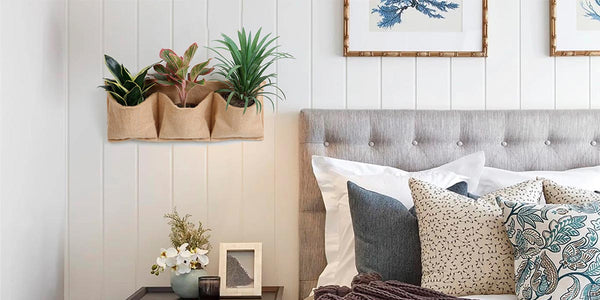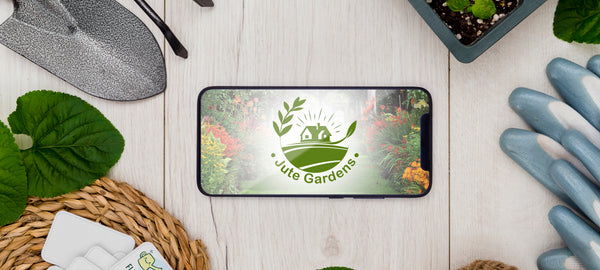
A Beginner's Guide to Indoor Vertical Gardening
Have you ever wished you could enjoy the benefits of homegrown fruits, vegetables, and herbs, but don't have the space for a big garden? Or maybe you wish to have some added greenery in your home but you live in the city or lack outdoor space for a traditional garden. This is a beginner's guide to indoor vertical gardening.
By gardening vertically, you can add plants to your interior design in a practical way. With limited space indoors, many people are opting for vertical gardens which take up minimal room. They have become popular among city dwellers with small balconies or patios. Even if you have more space outdoors, gardening vertically will help you make use of every square foot.

In this guide to indoor vertical gardening, we will explore the basics of vertical gardening and provide tips on how to get started with your own indoor vertical garden.
What is a Vertical Garden?
A vertical garden is a type of garden that is planted in vertically stacked layers or in some kind of hanging structure. This type of garden is perfect for small spaces, as it does not require a lot of room.
A vertical garden is a great way to grow herbs, vegetables, flowers, and other plants. They can be used to brighten up any space and add a touch of nature to your space.
Benefits of Vertical Gardening
- Get the most use out of a small area by utilizing all available space with your vertical garden.
- A vertical garden is easy to set up and maintain. Most vertical gardens are made from lightweight materials. This makes them easy to move and install.
- Not only do they provide beauty and fresh air, but they can also improve your air quality if used indoors.
- A vertical garden is also known to be more eco-friendly than traditional gardens, as they use less water and take up less space.
- If using outdoors, by bringing plants up off the ground, you make them easier to reach. Not only is it more convenient for tasks such as fertilizing, watering, pruning, and harvesting but it also saves your back from strain.
- By raising your plants off the ground, you improve air circulation and deter pests or diseases. You may also notice less damage to your plants from pet traffic or wild animals.
- If you're hoping to establish more privacy in your yard, consider planting a vertical garden. Vertical gardening is a fantastic way to conceal unsightly elements like air conditioners, garden sheds, compost bays, brick walls, or chain link fences.
- By adding a few key elements to your garden, you can vastly improve its appearance and make it more inviting. Add character with different varieties of plants, some structures with vertical garden displays, and color by choosing eye-catching blooms.
- Create clear boundaries and edges in your space with a vertical garden. Whether you want to make an entranceway or create a cheerful entranceway, your vertical garden will provide definition and give you a sense of privacy or seclusion.
Design Ideas
Vertical gardening is not just for outdoor spaces anymore. Interior designers are beginning to realize the potential of a vertical garden in interior spaces. By adding plants to your interior design in a vertical way, you can create a natural oasis in the middle of an urban environment.

A vertical garden can be used to add life and color to any room. They can also be used to hide unsightly elements in your home or to add privacy to a space. If used in an office environment, a vertical garden can help improve air quality and employee productivity.
Guide To Vertical Gardening Design
When designing a vertical garden for an interior space, it is important to consider the light and temperature conditions of the room. Most vertical gardens are designed for indoor use, but some can be used outdoors as well. Make sure to choose plants that will thrive in the conditions of the room.
Types of Vertical Gardens
There are many different types of vertical garden designs that can be used in interior spaces. Some popular designs include:
- Wall-mounted vertical garden: This vertical garden is attached directly to a wall and uses hanging planters or shelves to hold the plants.
- Floor-to-ceiling vertical garden: This type of vertical garden extends from the floor to the ceiling and is perfect for large spaces.
- Hanging vertical garden: This vertical garden hangs from the ceiling or from a stand and is perfect for small spaces.
- Window-box vertical garden: This type of garden is attached to the window frame and allows you to grow plants on your windowsill.
When choosing a design for your vertical garden, it is important to consider the amount of space you have available and the type of plants you want to grow. If you have limited space, a hanging or wall-mounted garden may be a better option than a floor-to-ceiling garden. If you want to grow large plants, such as trees or shrubs, a floor-to-ceiling garden may be a better option.
Choosing Plants
Once you have chosen a design, it is important to select the right plants for your garden. Be sure to choose plants that will thrive in the light and temperature conditions of the room. Choose plants that require similar amounts of water and sunlight so that you will not have to spend too much time caring for your garden.
Vertical gardening is not just for city dwellers with small balconies anymore. Commercial interior designers are beginning to realize the potential of vertical gardening in interior spaces.
Living Walls
Living walls, or green walls, are self-supporting gardens that can be attached to either the exterior or interior of a building. They are popular in commercial spaces. They're different from green facades (like ivy walls) because the plants take root in structural support that's fixed to the wall. The plants get water and nutrients from within the vertical support instead of from the ground.

Not only are living walls beautiful, but they also filter the air and have been known to increase productivity. Consequently, these days you'll see them often adorning the interiors of modern corporate campuses, particularly at businesses that prioritize social responsibility.
Living walls are an example of "biophilic design".
Biophilic Design
Biophilic design is a term used to describe the incorporation of plants and nature into the design of a space. It is based on the idea that humans are innately drawn to nature and that exposure to plants and nature can improve our mental and physical health.

Biophilic design has been shown to have many benefits for humans. Some of these benefits include:
- Reducing stress levels
- Improving air quality
- Helping to improve focus and productivity
- Helping to improve cognitive function
- Helping to improve memory
DIY Vertical Garden
A DIY vertical garden does not have to be expensive or difficult to build. If you are handy with tools, you can easily build your own vertical garden outside using a few simple materials.

Step1
The first step is to choose a design for your garden. There are many different types of vertical garden ideas to choose from.
Step 2
The next step is to build the frame for your garden. This frame can be made out of wood, metal, or plastic. It is important to make sure the frame is sturdy and will hold the weight of the plants.
Step 3
The next step is to attach the frame to the wall or ceiling. This can be done with screws, nails, or adhesive tape. Make sure the frame is securely attached to the wall or ceiling before moving on to the next step.
Step 4
The final step is to plant the plants in the frame. Be sure to pack them in tightly so they will not fall over. Once the plants are planted, water them well and enjoy your beautiful vertical garden!
Making a Vertical Garden From Recycled Materials
Making a vertical garden from recycled materials is a great way to upcycle old materials and help the environment. You can use almost any type of recycled materials to make your vertical garden, including empty plastic soda bottles, old tires, or wooden pallets.
If you're using plastic bottles, cut them in half and use the bottom half as the planter for your plants. You can either drill holes in the bottom to allow for drainage or place a small piece of gravel in the bottom of each bottle to help with drainage.
If you're using tires, cut them into rings and use the rings to create vertical pockets for your plants. If you're using wooden pallets, simply nail them together to create a vertical garden frame.
Once you have created your vertical garden frame, fill it with soil and plant your desired plants. Be sure to water and fertilize regularly to keep your plants healthy.
A Vertical Garden from Jute Gardens™
If you're looking for a vertical garden that is easy to use and perfect for both indoor and outdoor use, then a Jute Gardens™ Vertical Garden is a great option.

If you're looking for an environmentally friendly option, pocket gardens made from jute are a great choice. Jute is absorbent and decomposes naturally, so you can feel good about your impact on the planet. Plus, it's a renewable resource!
Jute Gardens' Vertical Gardens come in various sizes including 3-pocket horizontal, 3-pocket vertical, 4-pocket, 6-pocket, 9-pocket, and 12-pocket varieties.

The Best Place to Put Your Vertical Garden
A vertical garden is perfect for small spaces, so it is a great option for apartment balconies or patios. If you have more space outdoors, vertical gardening can help you make use of every square foot.
With sufficient support, lighting, water, and nutrients, you can successfully grow almost any plant indoors in a vertical garden that you could outdoors in a traditional garden bed.
If your indoor space is lacking natural light but you still want to attempt growing plants that require full sun exposure, consider using grow lights specifically designed for indoor plants.
With these tools at your disposal, the sky's the limit when it comes to what types of plants you can cultivate indoors.
Once you have chosen your plants, think about the layout of where you will put them and what purpose the vertical garden will serve.
If outdoors, pick a sunny spot for vegetables or herbs, or an area with natural light or grow lights if indoors. If your goal is to add color and beauty to the space, choose an area with partial shade instead.
Jute Gardens™ Vertical Gardens are made from a highly absorbent material. As long as you don't over-water your plants, they should not leak.
But if you're still skeptical, we have two tips that may assuage your worries. First, when planting indoors, keep the pots that your plants came in when placing them in each pocket. Second, if you are VERY concerned about spillage, lay down a plastic sheet behind your vertical garden to create a barrier between it and your wall.
Installing Your Vertical Garden
Jute Gardens™ Vertical Gardens can be safely used both inside and outside your home.

They come with convenient grommets and tabs for versatile arranging and decorating.
Step 1
Use screws or any outward extension to hang using the grommets provided (indoors or outdoors).
Step 2
Lay potted plants directly in the pockets and change them from time to time as you wish.
Step 3
Use a water sprayer and water regularly to keep plants healthy.
What Are The Best Plants for Your Vertical Garden?
When choosing plants for your vertical garden, it's important to consider the amount of sunlight the space gets, as well as the type of soil and climate. If you're not sure what types of plants will work best in your space, consult a gardening expert or online resource.
Click here for more information on which plants work best in a vertical garden, but some ideal examples include succulents, vines, ferns, and herbs.
When selecting plants for a vertical garden, it's also important to choose plants that have similar needs in terms of water and nutrients. Overwatering or under-watering can be detrimental to the health of your plants, so be sure to water and fertilize regularly.
A vertical herb garden is a great way to bring fresh ingredients directly into your home or restaurant. You can grow a variety of herbs in vertical gardens, including rosemary, thyme, basil, parsley, and chives.
Vertical herb gardens are a favorite for chefs because they are easy to access, and you can grow a variety of herbs in a small space. Having fresh herbs at your fingertips is a great way to add flavor to your dishes.
Examples of Vertical Gardens
Vertical gardens can be a beautiful and functional addition to any space.
Here is an example to get you inspired:
Vertical gardens are a great way to utilize vertical space and add color and life to any small outdoor or indoor space. They come in many sizes, and you can use them to grow a variety of plants- both indoors and outdoors. With the help of some light, water, and nutrients, you can successfully cultivate almost any plant in a vertical garden. So why not give it a try? You may be surprised at how much enjoyment you get from watching your garden grow!


